
Employee patience for unresolved workplace issue tanks post-pandemic

Written by

Director of People Science Research, Culture Amp

Senior Data Journalist, Culture Amp
We've all been there. The results of our employee engagement survey are in, and we open our dashboards to review the numbers. Then, we move on to the comments – and reading through them feels like riding an emotional roller coaster. People seem to either love or hate everything, making the feedback both exhausting to process and confusing.
Culture Amp is here to help. Since 2016, we have amassed ~75 million comments from two million employees spanning nearly 9,000 companies worldwide. Our surveys are unique in that they offer employees the option to add a comment to any rating question if they want to add detail or explain their quantitative response – and these comments are unsolicited. The comments in our data lake cover the gamut of employee experience, from compensation to leadership appraisal, onboarding to exit. We’ve analyzed them qualitatively and quantitatively so you can situate your employees’ comments in the broadest of contexts.
As we dive in, here’s a reminder to HR teams and leaders: Avoid writing action plans based on comments alone.
Here’s why:
Our previous analysis of comment trends found that comments are not representative of employee sentiment overall. Our latest analysis confirms that. As we will unpack, comments are pretty skewed:
- Employees are 8x more likely to leave a comment if they disagree with the question
- Negative comments are 2x as long
Throughout this article, we will identify common pitfalls to avoid when analyzing comment data – some of which stem from the points above.
Globally, employees have a lot to say about their experience. But what gets them talking most?
Employees have the most to say about the leader closest to them: their manager
It makes sense that employees often comment about their managers – people naturally pay the most attention to those with whom they spend the most time. Managers shape their direct reports’ immediate work environment. They are responsible for translating broader company goals into actionable tasks, recognizing employees’ achievements, and coaching employees through challenges. When employees talk about feeling supported, valued, or even stressed, they’re often reflecting on their interactions with their managers.
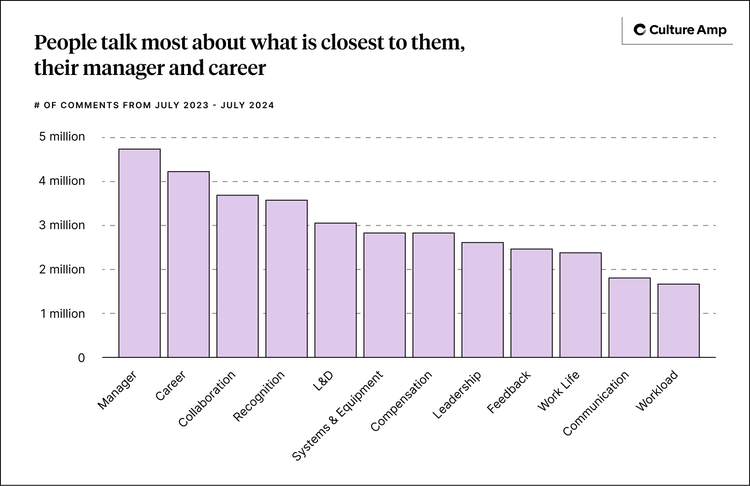
Historically, when we analyzed comment data, we found that employees had the most to say about collaboration. However, collaboration rarely drives engagement. Rather, top drivers of engagement typically involve leadership and career development. Assuming that the most commented-on topic is the most important is a common mistake HR teams make when analyzing comment data.
Along the same vein, we have found that employees’ perceptions of their managers have little to do with engagement. Despite the fact that it is the most talked-about topic, and the sentiment of manager comments has become progressively negative in the last two years, managers’ impact on employees is still outweighed by that of leaders. Assuming that employees’ perceptions of their managers drive engagement is another common pitfall.
However, the second most commented-on topic, the employee’s career, is a standing top driver of engagement year over year. Interestingly, when we looked at comment frequency within topics and spliced by leadership level, we found that comments about managers transcend level – everyone is talking about managers, even those in the C-suite. But, while career concerns rank within the top four topics for all levels below the C-suite, they drop off the radar at the executive level. Instead, executive leaders uniquely show the systems and equipment topic within their top four.
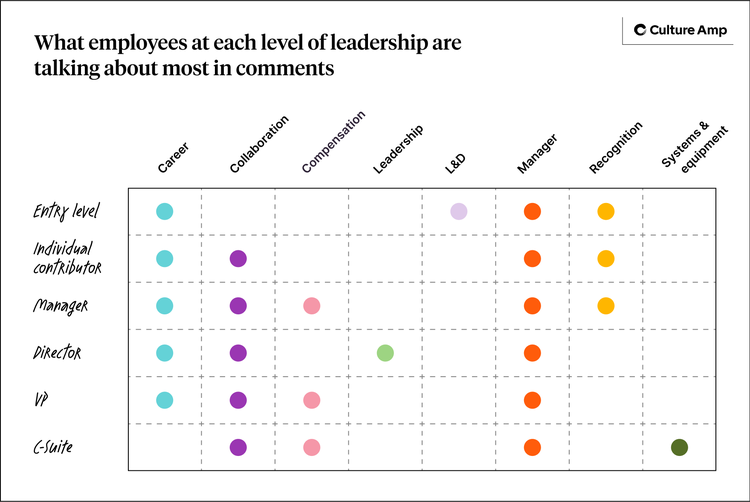
One unexpected finding? Compensation ranks as the 7th most commented-on topic globally, but the people disproportionately concerned with it aren’t who you might expect. Managers, VPs, and executive leaders are the ones who focus a majority of their total comments on this topic. This finding challenges the common assumption that compensation concerns are primarily driven by lower-wage employees.
We examined the more than 2.8 million comments employees made about compensation from July 2023 to July 2024 and found an unsurprising trend.
Employees care a lot about money– they have their mind on their money and money on their mind
Employees add the most unsolicited comments when asked about their agreement with the statement, “I believe my total compensation (base salary+any bonuses+benefits+equity) is fair, relative to similar roles at other companies.” Comments on that same question garner the highest negative sentiment (69% negative) and the lowest positive sentiment (4% positive) of all engagement questions and are five times less likely to be positive than comments overall.
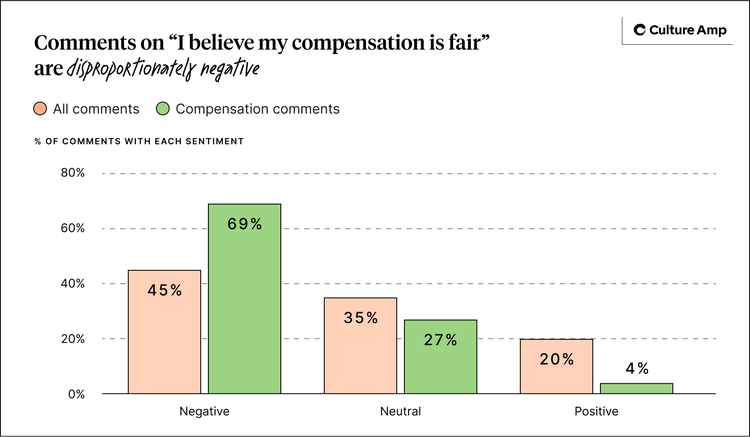
Employees often mention compensation, even when the question isn’t directly related to pay. For example, when asked about their confidence in the company’s future, compensation consistently emerges as a key concern. In uncertain times, pay becomes a tangible measure of how valued employees feel and how secure they believe their future is. This behavior aligns with equity theory, which suggests employees always balance their efforts against what they receive in return, such as pay and recognition. When they perceive an imbalance, compensation naturally becomes a focal point for their concerns.
Our people scientists use a framework, first developed by Dr. Roza Jankovic, for interpreting comments about compensation to help guide Culture Amp customers on when to take action on these comments and when they may not need to. Essentially, our people scientists have identified four orientations to compensation comments:
- Survival (references to cost of living, inflation, not enough to get by)
- Fairness (references to what others are making for the same work)
- Equity theory (reference to inputs and outputs being im/balanced)
- Market comparison (references to what they could be making elsewhere)
It is primarily the survival orientation that needs closer attention from HR teams. Other signs that indicate building an action plan based on quantitative compensation results paired with comments include compensation driver strength rising and decreasing motivation. However, compensation may not be driving engagement at your organization. Just as with management, give precedence to what drives engagement at your company, even if you’re seeing an influx of comments about compensation.
This is especially crucial in today’s workplace, where organizational needs compete for attention through employee feedback. As organizations sift through comments, it’s common to encounter conflicting perspectives on what truly matters. In fact, if you’ve recently noticed more comments pointing in opposing directions, you are not alone.
The neutrality bubble has popped as employees use stronger language in their survey comments
During the pandemic, we suspect many employees found themselves in what we’re calling a "neutrality bubble." This was a period when employees, perhaps unsure of what the future held, were more reserved in their opinions and feedback. Rather than expressing strong sentiments, they adopted a wait-and-see approach, often giving their employers and leaders the benefit of the doubt.
However, as we’ve moved beyond the initial shock and adaptation phases of the pandemic, this neutrality bubble has burst. Employees are no longer on the fence; instead, their comments show record-low levels of neutrality.
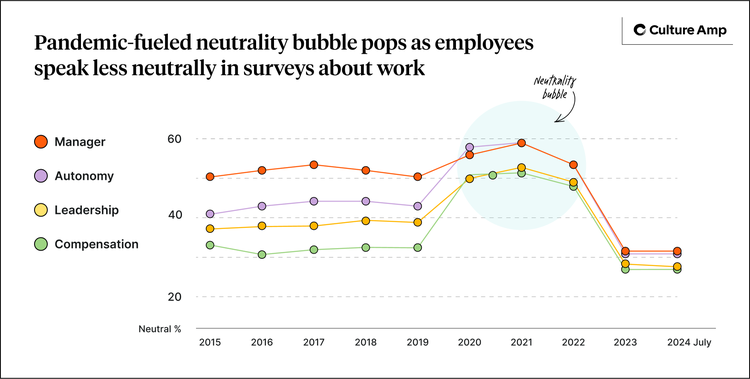
So where did employees’ neutrality go? Toward the negative, it turns out. Given the macroeconomic environment and how the talent market has shifted in favor of employers, employees may feel they need more extreme language to stand out. Their patience for unresolved issues may be waning, pushing them to take firmer, more negative stances.
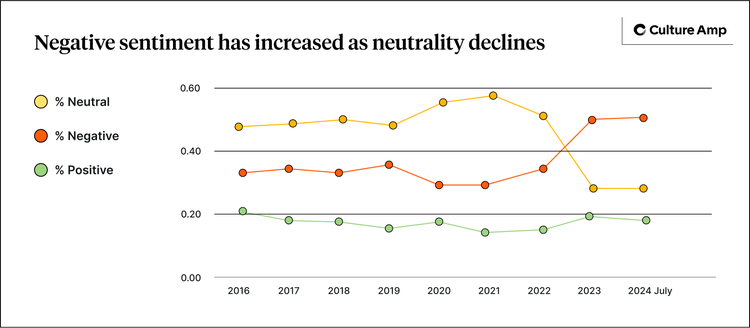
Here, we return to the experience of HR teams tasked with reading and processing survey comments. Our brains are already hardwired to see, retain, and act on negative information more than on positive information. This negativity bias is, of course, heightened when negative comments dominate, as they have this year.
Yet, there may be an upside to this surge in negativity: Employees are talking about what bothers them – they’re getting it out. Offering a space to voice their frustrations can act like a "name it to tame it" exercise, where simply expressing their concerns helps ease some of the tension. In this sense, the negativity is better out than in.
For companies, this highlights the need to continually create opportunities for employees to share their feelings and experiences. Expanding listening strategies – through more frequent surveys, open forums, or pulse checks – can help relieve the pressure employees feel, while also providing timely insights into emerging issues.
A concluding note of caution when interpreting comments
While employee comments offer valuable insights, there’s risk in relying solely on these comments for decision-making. As we’ve shown, comments, by their nature, often represent the most extreme ends of the sentiment spectrum – those who are either very satisfied or deeply dissatisfied are most likely to voice their opinions. This polarization can skew perceptions and lead to decisions that address the loudest voices rather than the majority experience.
Comments can provide important context and highlight critical areas of concern, but it’s essential to balance them with other data sources, such as quantitative survey results, performance metrics, and broader employee engagement trends. Relying too heavily on comments alone could result in misguided priorities that miss the mark on what the broader employee base truly needs.
By taking a holistic view – one that integrates both qualitative comments and quantitative data – organizations can more effectively navigate the complexities of employee sentiment.




